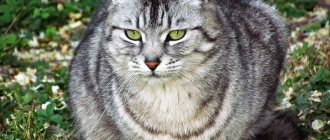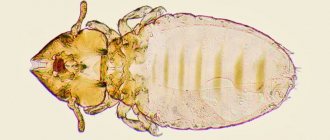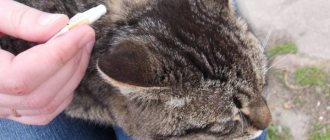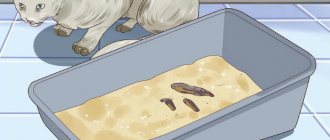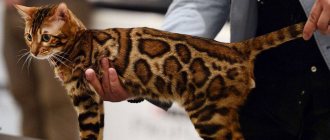Trichodectosis is the general name of a parasitic disease that can be caused in birds and animals by various arthropods belonging to the orders of lice and feather eaters, lice eaters and lice eaters (wool eaters). Including cats, they are susceptible to the disease caused by lice eaters.
This article was written within the framework of the information cluster of Acarosa for cats. Article continues after advertisement
Who are lice eaters in cats?
The scientific name of lice eaters that can parasitize the placental group of mammals, which includes the cat family, is Trichodectidae. Lice-eaters and lice-eaters, as well as wool-eaters (wool-eaters) are variants of the Russian-language name for parasites that live and parasitize in the fur of animals. These insects feed on skin cells, fur and body fluids of the host, secreted onto the surface of the skin naturally, as well as through scratching and injury. In English-speaking countries, the word "lice" is used - louse: it is applied to the same parasites that Russian-speaking veterinarians know as lice-eaters. With one caveat, that in their terminology Western veterinarians divide lice into biting/chewing and sucking lice.
Felicola subrostratus is an arthropod parasite that parasitizes exclusively on cats and causes the disease trichodectosis; in Russian-language literature it is called “the lice eater”, and in foreign publications it appears as “cat chewing louse”.
The causative agent of trichodectosis in cats has nothing to do with mites, as some owners sometimes mistakenly believe, calling the parasite a “hair-eater mite” and confusing trichodectosis with manifestations of sarcoptic mange (mange). Both pathogens are arthropod parasites, but that's where their similarities end. Itching mites belong to the class of arachnids and are infectious to humans, and the Felicola subrostratus species is an insect that cannot live on humans. They look, live, reproduce and feed differently.
The development cycle of the lice eater, which causes trichodectosis in cats, lasts 4-5 weeks. Every day, throughout her 30-day life, the female lays several eggs (they are also called nits). She attaches them to the base of the animal's fur. After 10-12 days, larvae (nymphs) hatch from the eggs of the lice eater, which in 2-3 weeks turn into an imago (mature individual). Understanding the life cycle is important for prescribing the correct treatment for the disease.
The cat lice eater is a specific parasite that spends its entire short life on the same host, i.e. on a sick cat. It is not capable of existing on other mammals, including humans. After leaving the cat's body, the parasite can survive for 5-7 days and then dies.
The main harm caused by cat lice eaters is economic, aesthetic and moral. Trichodectosis spoils the appearance and emotional state of a sick animal. The owner also experiences psychological discomfort when a pet is infected with a lice eater, and he is also forced to spend significant money and time on treating the animal.
The name of the disease “trichodectosis”, caused by lice-eaters of the suborder Trichodectidae, is used by veterinarians of the modern school. Previously, until 2001, veterinary dermatology specialists could call this same disease “mallophagosis” or “pediculosis.” The reason for this is the changed scientific classification since 2001, according to which two separate orders - lice and lice - were equated to four suborders of the family Phthiraptera, which is translated from Greek as “wingless louse”.
The danger of trichodectosis for cats
The danger of trichodectosis for cats is:
- possibility of helminth infection; lice eaters are carriers of helminth infections, for example, dipilidia caused by cucumber tapeworm;
- the possibility of allergic skin reactions, especially miliary dermatitis;
- the possibility of the emergence or aggravation of an existing immunodeficiency state and exacerbation of chronic diseases, including viral infections;
- development of anemia;
- weight loss;
- thinning of the coat, the appearance of foci of alopecia (baldness), and a decrease in the attractiveness of the appearance of the coat.
Waste products of parasites visible in a cat’s fur are one of the symptoms of lice-eater infestation
Ways of infection with trichodectosis
Lice eaters are quite rare parasites in cats. Young, old and weakened individuals are more susceptible to trichodectosis. Without direct contact with a carrier of parasites, it is almost impossible for a healthy, well-groomed animal to become infected.
Lice eaters in most animal species have the ability to parasitize only certain warm-blooded animals. Thus, cat lice parasites can live only on cats, canine parasites on dogs, and human parasites on humans.
Article continues after advertisement
Lice eaters in cats have a structure that does not allow them to move from one owner to another. These ectoparasites spend their entire life cycle on one host - a cat, unless a forced “relocation” occurs, for example, through direct contact of a sick animal with lice on its fur with a healthy individual or by using care products and equipment from an infected cat on a healthy one.
Transmission routes and risk factors
The appearance of lice-eaters is possible at any age, regardless of gender or seasons. Parasites are transmitted by contact when communicating with a carrier. This could be another cat, a dog, large pets and livestock, as well as rodents that the cat hunts. If a mother cat is infected with lice eaters, then they move onto the kittens.
In rare cases, it is possible that eggs or larvae of lice beetles may be transmitted on poorly sterilized tools used by the groomer.
Meeting parasites does not always lead to infection. If the cat receives good care and a balanced diet, then its immunity will allow it to cope with infection.
Animals whose immune systems, for one reason or another, do not function well enough, are at greater risk of contracting parasitic insects. This applies to small kittens and very elderly cats. Immunity may decrease after an infectious disease or surgery.
There are insufficient protective forces in animals that have severe chronic pathologies.
Trichodectosis in cats: symptoms
Depending on the severity of the disease, symptoms may vary slightly in intensity. But owners should know the main signs of lice in cats:
- restless behavior associated with itching and intense scratching of the affected areas;
- the fur of sick cats is dull, broken and tousled;
- whitish balls (nits) are present at the base of the hair shafts;
- adult parasites measuring 1-1.5 mm in size are noticeable on the skin and in the down;
- if the intensity of invasion (infection) is small, then nits and parasites may be invisible to the naked eye, but scabs, abrasions from scratching, flakes of skin epithelium resembling dandruff, as well as bald patches will be visible;
- the presence of lice eaters in a cat can even cause necrotic symptoms on the skin due to deep injuries and suppuration after intense scratching;
- in severe cases, the lice eater in a cat can cause anemia and all the troubles associated with it.
Understanding how hairworm manifests itself in a cat allows you to take timely measures in case of suspected infection and successfully provide timely assistance to a sick animal. At the first signs of lice in cats, you should immediately contact a veterinarian for dermatological examinations and an accurate diagnosis. This is especially true if there is more than one cat in the house or if there is a risk of infection of other people's cats, for example, at exhibitions.
Signs of presence
How to determine by external signs whether your kitten is infected with lice or not?
Firstly , he will strongly scratch the bite area, the itching is especially severe at night, the cat practically does not sleep because of this. The pet will bite parasites and actively lick the fur.
Secondly , the cat stops listening to the owner, stops playing, becomes irritable and lethargic.
Thirdly , in places where a large number of insects accumulate, baldness appears, as well as dry white elements similar to dandruff.
Murkoshi specialists advise using one method to detect the presence of lice eaters. Bring a light bulb to your cat and in a few minutes you will be able to see parasites gathering in the warmth at the ends of the hairs. No other insects will do this. It should be noted that bacteria and infection can enter the combed areas and, as a result, inflammation will begin. Therefore, it is necessary to start treatment as quickly as possible.
Diagnostics
The best option to diagnose trichodectosis is to contact a competent veterinarian who has the opportunity to professionally examine, provide assistance and advise. A veterinarian, based on anamnesis (the history of the onset of the disease told by the owner), clinical examination, microscopic examination and differential diagnosis (excluding diseases with similar symptoms), will be able to accurately determine whether the cat is infected with Felicola (feline beetle).
Similar diseases that should be excluded if a diagnosis of trichodectosis is suspected are:
- flea dermatitis;
- cheyletiosis;
- atopic dermatitis;
- food allergies;
- thrombidiasis.
For various reasons, it may not be possible to conduct a diagnosis from a veterinarian. How, then, can you determine whether a cat has lice eaters? In this case, those owners who have access to a microscope will have an advantage. They can use the tape test imprint method: the adhesive side of the tape is applied to suspicious bald spots on the cat, pressed, then torn off and transferred to clean, grease-free glass, to which it is glued. The imprint obtained in this way is examined under a microscope in search of nits and adult ectoparasites. The cat Felicola subrostratus looks like this.
Lice eater under a microscope
If there is no tape, you can scrape the skin using a disinfected sharp blade: you need to scratch the skin with it until the ichor is gone. Spread the released liquid, skin cells and some hair from the affected areas in a thin layer on a glass slide. Place 1-2 drops of saline solution (from a regular pharmacy) or clean (preferably distilled) water on top of the smear. Cover such a smear with a cover glass and examine it at low magnification in a conventional biological microscope.
If you don’t have access to a microscope, then you can only rely on your vision and logic. It is important to think: what life circumstances preceded the manifestation of symptoms and could cat lice eaters attack the animal as a result of these circumstances?
Why are they dangerous?
In the course of its life, the cat's hair eater provokes the development of allergies and dermatitis in the pet. The obsessive itching of the skin in the areas where these insects are located gradually intensifies, leading to scratching and abrasions into which bacteria enter. As a result, an inflammatory process develops, which is accompanied by ulcers, redness and swelling of the skin. Against this background, the cat’s fur deteriorates, concomitant chronic diseases in the animal’s body worsen, and health deteriorates.
Cat and dog lice eaters are intermediate hosts of parasitic worms and worms. They also carry Rickettsia and Bartonella on their bodies, which cause infectious diseases.
Infection of a kitten or puppy with lice eaters can negatively affect further development and even cause death. After all, the immature immunity of animals at an early age is not always able to withstand such a load.
How to remove hairworms from a cat: treatment of trichodectosis
The fight against lice eaters and hair eaters is quite simple. These insects are easily killed by all kinds of cat products used to control fleas and ticks. In this case, the owner has the opportunity to choose any convenient form of the drug: sprays, drops, shampoos, collars and powders.
The most effective and safe remedy for lice for cats can have any commercial name, but the main thing is that the active ingredients in it are the following:
Article continues after advertisement
- selamectin;
- imidacloprid;
- fipronil.
Information about the active substance can be found at the beginning of the instructions for the product.
Preparations for hairworms in cats, the active ingredients of which are pyrethrins and pyrethroids or carbamates, should be used only as a last resort and with great caution, because Cats' bodies can suffer greatly from poisoning with these substances. In this regard, such drugs and collars were prohibited for sale in the United States. In our country they are still allowed, but some cats die as a result of the use of such poisons.
Any treatment must be comprehensive. Depending on the clinical picture, the treatment regimen should be selected individually. Considering that the cat's hair eater is located in the cat's fur, it is necessary to conduct a visual assessment of it and, if necessary, completely remove the hair in the affected areas.
If the infection stage is initial, you can resort to the folk remedies described below. But if the cat’s lice-eaters do not go away and treatment does not give the desired effect, then you should immediately turn to traditional therapy.
In more serious cases you may need:
- antibiotic therapy;
- hepatoprotectors;
- vitamin and restorative preparations;
- anthelmintics;
- antifungal agents;
- antitoxic agents with infusions (droppers).
Can it be treated at home?
If the lice-eater infestation has occurred recently and the damage is minor, you can try to treat the animal at home. To do this, you should purchase drugs against ectoparasites (fleas, ticks, lice):
- pet shampoos (“Demos-Lux”, “Flea&Tick Cat Shampoo”, “Bolfo”, “Shampoo B”, “Rolf Club”, “Mr. Kiss”, “Bars”, “Clandestine”, etc.);
- drops (“Bars”, “Clandestine”, “Biafar”, “Frontline”, “Barrier”, “Hartz”, “Advantage”);
- aerosols and sprays (“Bolfo”, “Acaromectin”, “Flea & Tick – 14 Residial Spray”, “Delix-spray”, “Serco”, “Frontline”, “KiSka”).
These medications should be used with extreme caution if lice eaters are found in a kitten. For small animals with weak immunity, you should use a lower dosage, which your veterinarian will help you choose.
Folk remedies used by animal lovers at home are not as effective as specialized drugs. However, they may well be used in the early stages of infection. For example, an animal can be bathed in a strong decoction of chamomile, string or wormwood.
Preparations for lice in cats
Modern veterinary pharmacies offer a huge number of medications for lice in cats with a wide range of prices. All drugs used to kill lice eaters act on their nervous system and cause the death of parasites. But few products destroy the eggs and larvae of Felicola, so after a while, when they turn into adults, repeated treatments are carried out.
It is natural that all drugs used to kill lice eaters have some toxic effect on a warm-blooded animal, in our case, a cat. Therefore, it is of great importance which remedy for lice is prescribed to a particular patient to achieve maximum therapeutic effect with minimal harm to the victim.
Here are some drugs (commercial names) prescribed for lice in modern veterinary medicine.
Bravecto (drops on the withers)
The active ingredient is fluralaner from the insectoacaricidal group of isoxazoline.
It must be used with caution, observing the dosage, because... There are known cases of side effects in mammals. BUY IN UKRAINE
Article continues after advertisement
Advantage (drops on the withers)
This drug for hairworms in cats is often recommended in pet stores and veterinary pharmacies.
Active ingredient: pesticide imidacloprid, also sold under the commercial names “Confidor”, “Kopfidor”, “Admir”, “Gaucho”. Belongs to the class of neonicotinoids. BUY IN UKRAINE
BUY ON AMAZON
Stronghold
“Stronghold” (drops on the withers) is one of the most successful and recommended remedies for lice in the USA and Europe.
It's all about the active ingredient selamectin, which is well tolerated by cats. BUY IN UKRAINE
Leopard (drops on the withers)
A popular remedy for lice eaters and other arthropod ectoparasites.
Contains 3 active ingredients at once: fipronil, diflubenzuron, dicarboximide. Its popularity is mainly due to its relatively low price. Article continues after advertisement
BUY IN UKRAINE
Manufacturers also offer all kinds of forms of antiparasitic drugs: sprays, collars, injections, drops against lice in cats. What's better? What to choose? In fact, there is little difference in what form the drug will be used. To begin its work, any insectoacaricide needs to reach the parasite with food. And their food is blood and lymph. This means that any remedy for fleas, lice, lice and ticks for cats is partially absorbed and circulates in the animal’s blood. From here it becomes clear why there are cases of toxic poisoning of cats themselves after the use of drugs, and not just the death of parasitic insects.
When using any medicine for lice, it is important:
- observe the dosage, taking into account the weight of the animal;
- for cats, use only products for cats, take into account your animal’s individual tolerance to one or another active substance;
- give preference to drugs banned in other countries due to the content of tetrachlorvinphos (an officially recognized carcinogen), only in cases where the expected benefit to the animal is higher than the harm from possible side effects: keep in mind that even such reputable companies as Hartz, Beaphar , Zodiac and others produce similar products, therefore, when choosing a drug, read the composition, and do not blindly trust the famous manufacturer;
- use medications only in cases where the pet belongs to acceptable groups of animals: by age, species, pregnancy and lactation.
And once again we emphasize that any synthetic parasite repellents are potentially dangerous for pets. After using the drug, save the packaging. After using drops, sprays and collars, as well as administering injections, be sure to monitor the animal’s well-being. In case of any deterioration, you should immediately contact your veterinarian for antitoxic therapy.
Description of the cat lice eater
The cat lice eater looks like a flat beige bug several centimeters long (usually 1-2 cm).
The structural features of the cat lice eater are as follows:
- wings are missing;
- the belly is elongated, oval-shaped, covered with bristles;
- the breast is underdeveloped, divided into three segments;
- three pairs of legs are equipped with hooks that dig into the cat’s skin;
- the head is disproportionately large, has short mustaches;
- mouth is large;
- triangular eyes are underdeveloped;
- color varies from whitish to light red.
The exoparasite feeds on the animal’s blood, dead epidermis, and particles of fur.
The female lays 100-120 eggs on the fur, attaching them to the hairs with sticky mucus.
The larvae go through 3 stages of maturation in 28 days, turning into adults. Rapid reproduction occurs in autumn and winter. Lice eaters, unlike lice and fleas, cannot survive without the host's body.
Folk remedies for lice
When there is no desire or opportunity to use synthetic products to treat cats against lice at home, and the infestation is small or absent (that is, we are talking about prevention), you can use folk remedies.
Option 1
Bathe the cat in a decoction of herbs: wormwood, medicinal chamomile and string. To prepare a decoction, the herbs must be taken in equal parts. The color of the finished decoction for bathing the animal should be close to the color of pale tea.
Option 2
It is quite acceptable to bathe a cat or kitten in tar shampoo for animals or people. But tar soap or shampoo does not destroy the lice eater. Birch tar helps weaken adults and has no effect on larvae and eggs. In addition, tar dries out the skin and coat, so you need to add burdock oil to your soap or shampoo. The soaped animal should be wrapped in film up to its neck or placed in a bag, leaving its head exposed to the air. Wrap a towel on top and hold the wrapped cat in your arms for 20-30 minutes to enhance the effect of the tar. You can't let him lick his lips. Then rinse thoroughly and comb out the lice with a very fine comb or cut the hair as short as possible. The procedure should be repeated once every two days at least 5 times.
Option 3
Get a comb with fine teeth, which is convenient for combing out parasites. Trim your cat's fur as short as possible whenever possible. Good lighting and vision, perseverance and patience will help mechanically remove parasites from the surface of the skin. To make the work easier, you can wash your cat with tar shampoo or soap before doing this. Then the lice-eaters will weaken and it will be easier to eliminate them.
You can combine all three options. Other means can also be used. The main thing is that the owner understands the difference between treatment with synthetic drugs and natural ones. In the first case, the parasites are quickly and reliably destroyed, but this method can be toxic for the cat itself. In the second case, folk remedies will gradually alleviate the situation, slowly and gradually improving the cat’s health, but you should be patient and systematically, without interruptions, carry out procedure after procedure.
Preventive measures
To avoid infecting a cat with a lice eater, the following preventive measures must be observed:
- every week inspect the animal’s fur and skin for the presence of parasites;
- use an insecticidal collar when walking;
- do not allow the cat to communicate with stray cats;
- feed with balanced food;
- Wash the tray in a timely manner;
- monitor the cleanliness of beds, toys, rugs used by the pet;
- deworm your cat quarterly;
- bathe your cat regularly using special anti-parasitic shampoos;
- When purchasing a second pet, carefully examine its fur for the presence of lice;
- Visit the veterinarian regularly and get vaccinations to prevent skin diseases.
Proper care and the owner's attentive attention to detail are the key to healthy skin and fur of a cat. If the problem is noticed in time, it will allow you to get rid of parasites as soon as possible and prevent the pet’s condition from worsening.
Treatment of trichodectosis in kittens
Kittens are at risk of becoming infected with lice because of their not yet fully formed immunity. There are three easiest ways for a kitten to get sick:
- receive parasites from the mother;
- upon contact with sick fellow tribesmen;
- from the use of ammunition and care items that have been in contact with a sick animal.
Treatment for lice in kittens is absolutely identical to how adults are treated. With the exception of one important nuance: only those drugs are used that are acceptable for use on kittens. The permissible age is always indicated in the instructions.
In addition, it is strictly forbidden to use aggressive folk remedies against ectoparasites on kittens:
- kerosene;
- table vinegar;
- cosmetic hairspray;
- vodka and other alcohols;
- combine tar-containing shampoos and soaps with dust and laundry soap.
Symptoms of the lesion
The activity of lice eaters leads to the following pathological symptoms:
- Itching: the arthropod gnaws the skin, inflammation occurs, the cat scratches the itchy areas, and ichor leaks out. It dries out and crusts form. Secondary microflora joins in and the itching intensifies.
- A rash appears and pustules form. The saliva of parasites, when repeatedly penetrating skin defects, causes sensitization and an allergic reaction.
- Hair loss. Lice eaters can destroy a fur coat over a large area.
- Ulcers on the skin.
- Mats in long-haired cats.
- The skin becomes inflamed, rough, swollen, and rough.
- Segments of cucumber tapeworm are found in feces.
- Against the background of a decline in immunity, subcutaneous mites - demodex - develop; notoedrus; otodectes.
Consequences of the disease
In general, the prognosis for cats infected with trichodectosis is positive. But it all depends on age, the body’s immune response, the degree of invasion and the measures used for treatment. Trichodectosis in a cat can be easily treated under the guidance of a competent veterinarian, and risks and side effects are minimized. Therefore, if possible, be sure to consult a veterinarian rather than self-medicate.
Advanced cases of lice-eater infection in weakened cats can even be fatal. Thoughtless use of anti-ectoparasite remedies can also be disastrous for the cat. According to foreign studies, any synthetic insectoacaricides are potentially dangerous for warm-blooded animals, but to varying degrees. Some cause toxic poisoning and even death without emergency treatment. There are drugs that cause cancer and other related disorders in the body. Over time, such drugs are discontinued or banned for use on pets.
Is the lice eater dangerous for humans?
Scientists are divided into two camps when speaking on this topic. Some of them claim that with close contact between an animal and a person, infection is possible. If you suddenly notice that you have itching or bald spots on your head, you should consult a doctor. He will examine you and make an accurate diagnosis.
Another group of scientists says that they are not dangerous for humans and their hair. The fact is that cats and dogs have a fairly high body temperature, which is an excellent condition for the life and reproduction of the parasite. Once on human skin, the only threat will be bites, because the insect will not live long.
lice eaters
Prevention
The fight against lice eaters comes down to routine preventive measures for every domestic cat. Proper prevention includes a healthy diet, hygiene procedures, regular health monitoring and the use of the most gentle preventive agents against ectoparasites with strict adherence to all recommendations from the instructions of the drugs.
It is important for every owner of a domestic cat to understand that any medications for fleas, lice, ticks, lice eaters, and hair eaters are not a toy. You cannot, in the hope of saving a cat from lice eaters, douse and weigh it down with everything that the pet market offers. For example, some people like to put a collar on and apply drops to the withers, thus giving the animal a double dose of insectoacaricides. Everything must be thought out and balanced. Prevention should be done in moderation. What is excessive is also bad.
Caring for a sick animal
A cat infected with trichodectosis does not require special care. There is also no need for nutritional correction. After the first use of medications, the pet’s well-being, as a rule, improves. To speed up the animal’s recovery, after identifying lice eaters, you must:
- carry out wet cleaning of the home by treating the surfaces with which the infected animal has come into contact with a napkin moistened with 2% Neostomozan, Ecocide or Ectomin;
- vacuum and steam toys, bed, scratching post, pet play structure;
- treat wounds with an antiseptic, for example Chlorhexidine, best done with sterile gauze;
- After finishing treatment, give the cat an anthelmintic.
If a cat is diagnosed with trichodectosis, it must be isolated from other pets. This measure will prevent them from becoming infected.
How to treat a room against lice?
Despite the fact that Felicola (the cat hair eater) can exist without food, that is, in the external environment, for up to 7 days, and then it dies, any owner wants to get rid of it as soon as possible. Naturally, if a sick cat lives in a residential area, some individuals of lice or lice eaters may be found in the apartment.
To destroy insects indoors or on care facilities for sick animals, basic treatment against lice by spraying insectoacaricides will help. The most accessible means for these purposes are preparations with the active ingredient deltamethrin (commercial name “Butox”, etc.) or tetramethrin and transmix (“Neostomazan” and analogues). Along with them, you can use other insect repellents.
The contents of the ampoule with the drug must be diluted in water in the proportions specified in the instructions. Using personal protective equipment (gloves, goggles and a respirator), spray the entire room. Due to the fact that the lice eater cannot fly or jump, it is enough to treat the surfaces where the cat is, as well as the entire floor. The treatment will not affect eggs and larvae that the cat may have “lost,” so spraying should be repeated after 3 days.
Only one person is in the room during processing. Animals and other people are removed to other rooms. After treatment, it is imperative to ventilate the room well: only after this can animals and people be allowed to return to it again.
Rate and share!
Stages of development of feline trichodectosis
In the development of trichodectosis, 3 stages can be distinguished, the duration of each of them is determined by the number of pathogens, the state of the cat’s immune system, as well as environmental conditions:
- initial stage - there are still few parasites, the cat feels satisfactory, sometimes itches with its paw, there may be occasional scratches on the skin;
- stage of the height of the disease - with an increase in the number of lice-eaters, all the symptoms typical of trichodectosis appear: thinning of the coat and areas of baldness;
- severe skin itching;
- multiple traces of scratching on the cat’s skin;
- disturbance of general well-being and behavior;
- dandruff appears;
- allergic reactions: this intensifies skin itching, which ceases to depend on the activity of parasites, as well as their number, and becomes permanent and intense;
- redness and swelling of the skin around the lesions;
- weight loss;
- viral leukemia;
Causes of ectoparasites
The reproduction of insects on a pet’s body can be caused by various factors, from direct contact to unacceptable living conditions. Here are the most common routes of infection:
- Rarely performed sanitary and hygienic procedures (bathing, brushing wool).
- Contact with infected animals.
- A damp and damp room in which a dog lives.
- Unbalanced diet, deficiency of essential elements.
- Infection from mother to newborn puppies.
How can a pet become infected?
Ticks are transmitted from one animal to another in the following ways:
- Contact. Infection occurs when animals are kept together in nurseries at exhibitions, in veterinary hospitals, and during mating.
- From the owner's shoes, clothes. A person can carry parasite eggs into the house.
- Through personal items: leashes, collars, muzzles, and brushes.
- From a sick mother at birth. This route of infection is typical for puppies.
- During grooming when using unsterilized instruments.
Factors contributing to the infection of a pet are unsatisfactory living conditions, poor nutrition, and the presence of chronic diseases in the dog. The chances of transmitting the parasite from one individual to another increase in the autumn-winter season.
The first signs and symptoms of infection
The initial stage of infection of an animal by parasites is characterized by the following processes:
- Hair loss. Your pet develops bald spots on its back, near its tail, as well as on its muzzle and inner thighs.
- Worry.
- Constant itching, increasing as the disease progresses.
- Deterioration of the condition of the coat. She becomes dull and disheveled. An attentive dog breeder may find dense white grains on the hairs - these are parasite eggs.
- Decreased immunity. A pet suffering from ticks is constantly sick, catches colds easily, becomes lethargic, and loses interest in walks.
- Puppies may experience developmental delays due to lice eaters.
As the disease progresses, the affected areas of the dog's body completely lose their fur, and festering sores form on the skin. Due to constant itching, the animal refuses food, cannot sleep for a long time, cannot stand in one place, constantly itches, and bites into wounds. If the disease is prolonged, the bald areas may become infected with a bacterial infection.
Diagnostic measures
Diagnosis of trichodectosis consists of a visual examination of the animal's fur, on which lice eaters of various stages of development can be found (adults, larvae, eggs). To facilitate this activity, the dog is heated with an electric lamp or in open sunlight so that the insects crawl to the surface and become more visible. To exclude other pathologies of parasitic origin, scrapings are taken from the skin and examined microscopically in a veterinary clinic.
Reviews
Oooh, we encountered this problem.. I’ll tell you - it’s HORRIBLE. Our poor dog. (At first they didn’t understand what was happening, he didn’t eat anything, we took him to the veterinarian, and he told us “this is acclimatization” (before that we went to the sea with the dog) We believed it, we waited.. And then it got even worse, It started to itch just horribly, and then we already understood! First of all, we bought a special collar, then full care began... shampoos, creams, we even went to a special salon for animals, where our baby had some procedures (she and her husband went , so I won’t say exactly which ones)) It’s good that everything worked out well, and this infection did not bring us any infections. Now we check the dog every month! Take care of your little ones!
Marina, St. Petersburg
***
The shampoo as in the picture helped us. True, I had to empty almost the entire bottle. So far this infection is not visible.
Oleg
***
Once I bought an adult pregnant bitch. The bitch did not itch, but the puppies began to itch at the age of 6-7 weeks. Our old bitch was itching the same way. Turned out to be a hair eater. The entire kennel was treated with the drug Strong Hold, which is also poured onto the skin of the withers. The drug helped and no one had any side effects. True, sometimes Strong Hold itself can cause a local reaction - the dog scratches the place where the drug was poured. But this is quite rare. I only encountered this once myself.
Oksana, Saratov
***
Drops on the withers "Bars". The active ingredient is permethrin. I determined that the lice eater was like this: 1. The dog is itching wildly. 2. Upon examination, no fleas were found (they are quite noticeable). 3. There are areas of redness on the skin, similar to hives (here it is necessary to differentiate from allergies). 4. There are small scabs with scabs. 5. I found the lice eater itself. 6. I looked at it through a microscope (luckily I have a laboratory microscope at home) - it’s definitely a lice eater - it’s hard to confuse it.
Speaking of pet shampoos, Lugovoi shampoo contains the same active ingredient. I decided not to wash the dog with it yet - stop poisoning the puppy. Tomorrow is the first vaccination, I think I will wash it a week after it.
I read about StrongHold - it seems like a good drug. The active ingredient is different. I looked for variants of its different trade/chemical names - it does not overlap with permethrins, although the principle of action is somewhat similar.
Vitaly, Moscow region
*Based on the results of my own work and colleagues from hloptarakan.ru, stopvreditel.ru
Treatment procedure
After treating the animal's fur with a special product, you need to carefully comb the fur with a comb. After combing out all the fur, you should destroy all the insects that still remain and their larvae. All items that the dog has used must be carefully collected and boiled. If boiling is not possible, they will have to be thrown away. If lice eaters were found in small puppies, pregnant or lactating bitches, then treatment should be carried out very quickly. The presence of insects in an animal greatly reduces the immune system. After all this, you need to give the dog an anti-worm remedy.
